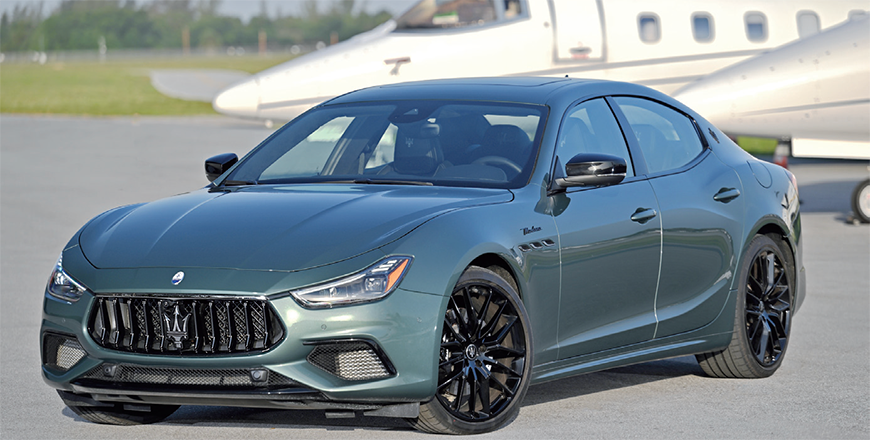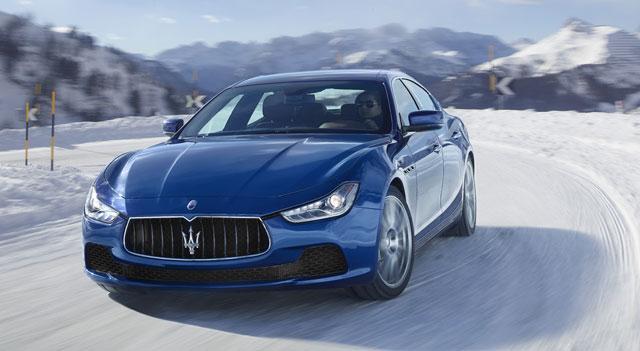You are here
Exotic Italian executive motoring
By Ghaith Madadha - Jun 15,2015 - Last updated at Jun 15,2015

Photo courtesy of Maserati
An everyday exotic yet practical, refined and well equipped executive saloon, the sporty, swift and smooth Maserati Ghibli is pitched at traditional premium saloons like the Audi A6, Jaguar XF and BMW 5-Series, and fashionable so-called “four-door-coupes” like the Mercedes-Benz CLS-Class, Audi A7 and BMW 6-Series GranCoupe. 
Evocatively resurrecting the former sports car and coupe Ghibli nameplate after a 15-year absence, when introduced in 2013, the contemporary twin-turbocharged V6 Ghibli also revisits the iconic Italian brand’s 1980s bi-turbo V6 foray into the executive saloon segment. But with seductively curvy lines, sharp ridges and moody face rather than a traditional angular three-box design, it is possibly the most glamorous in its class.
Dramatic design
Dramatic, predatory and athletic, the Ghibli is brimming with dynamic tension. From its’ low-set concave vertical slat grille, squinting, heavily browed headlights and across its’ voluptuously carved sports car-like scalloped wings the Ghibli’s design creates a sense of motion and urgency. A flowing roofline, frameless windows, long bonnet, cabin-back silhouette and short high-set rear deck emphasise its luxuriously sporty demeanour.
Sculpted and sporty, the Ghibli’s curved surfacing features prominent sills, muscular Coke-bottle hips and rear haunches. Front views are dominated by the evocatively edgy Maserati Trident badge, while a wide lower intake lends the Ghibli a hungry and eager appearance, and three side ports accentuate its indulgently long bonnet.
Low, wide and well proportioned with short front overhang and big footprint, the Ghibli is road hugging and hunkered down. With traditional front engine and rear-wheel-drive layout, the Ghibli has equal front-to-rear weight distribution, for balanced, neutral and adjustable handling characteristics. Meanwhile, scalloped wings serve as turning point markers to help place it on road through corners.
Swift and smooth
Located in a somewhat front-mid configuration and driving the rear wheels through a smooth and swift changing 8-speed automatic gearbox, the Ghibli’s Ferrari-developed 3-litre twin-turbocharged V6 delivers 325BHP at 5000rpm and 407lb/ft
throughout a broad 1750-4500rpm torque band.
Despite being the entry-level model in the Ghibli range performance is swift with 0-100km/h dispatched in 5.6 seconds and a 263km/h top speed.
Smooth, versatile and powerful, the Ghibli’s refined and efficient engine spools quickly from tick over and features good throttle responses for fluent driving.
Pulling hard from low-end, the Ghibli’s flat torque band ensures flexible responses and effortless cruising in tall gears over a broad mid-range, while urgent power buildup is underwritten by a wave of seemingly ever-accessible torque.
Achieving its potential at relatively low-revving points, the Ghibli’s engine is nevertheless willing, responsive and eager through revs, and features a distant and subdued but visceral growl. With its broad mid-range muscle and direct fuel injection, the Ghibli returns good fuel efficiency, with 9.6l/100km consumption and 223g/km CO2 emissions on the combined cycle.
Supple and sporty
Smooth and supple yet agile, responsive and balanced, the Ghibli well reconciles sporty handling characteristics with comfortable ride qualities.
Riding on double wishbone front and multi-link rear suspension with forgiving damper and spring rates the Ghibli absorbs imperfect road textures in its stride, especially when driven on Jordanian roads with more supple 235/50R18 tyres.
With optional lower profile 245/45ZR19 front and 275/40ZR19 rear tyres, as previously driven in Oman, the Ghibli may have generated more ultimate lateral grip.
However, for local roads, the taller base alloy wheel and tyre choice delivers a more fluent ride, in addition to transmitting more nuanced road feel and steering precision over rougher surfaces.
Agile and pointy through winding country lanes, the Ghibli’s combination of keen handling and forgiving ride well-suited rural Jordanian switchbacks.
Turning-in tidily the Ghibli’s supple suspension may allow for mild body lean, but weight transfer was well contained. Additionally, the Ghibli’s sweet chassis was balanced, nuanced and adjustable on throttle, while a limited-slip rear differential distributes power where needed.
Refined and stylish
Refined, stable and smooth at speed, the Ghibli’s ride dispatches rough textures with supple nuance and feels alert and ready. Over rebounds it recovers in a settled buttoned down manner. Inside, it is refined and well-insulated harshness, vibrations and noise.
Meanwhile, the Ghibli’s electronic stability controls reassuringly and briefly intervene if grip limits are exceeded in corners.
Classy yet sporty and stylish inside, the driven Ghibli’s cabin featured leather upholstery, suede-like roof liner and open pore wood grain trim. With good fit, finish and quality almost everywhere, the Ghibli is also ergonomic and driver-focused, with supportively comfortable seats, well-adjustable driving position, clear instrumentation, good front visibility and useful storage spaces, including its 500-litre boot.
Offered with extensive trim personalisation and standard and optional modcon and safety features, standard equipment includes Bi-Xenon and adaptive lights, dual zone climate control, speed sensitive steering, rain sensor, Bluetooth connectivity and intuitive infotainment and driving menus.
Optional equipment includes Satnav, sunroof, remote start, adjustable pedals, steering-mounted paddle-shifters and rear parking camera and other systems.
TECHNICAL SPECIFICATIONS Engine: 3-litre, in-line, twin-turbocharged V6 cylinders Bore x stroke: 86.5/84.5mm Compression: 9.7:1 Valve-train: 24-valve, direct injection, variable valve timing Gearbox: 8-speed, automatic, RWD, limited-slip differential Power, BHP (PS) [kW]: 325.5 (330) [243] @ 5000rpm Specific power: 109.3BHP/litre Power-to-weight: 179.8BHP/tonne Torque lb/ft (Nm): 406 (500) @ 1750-4500rpm Specific torque: 167.8Nm/litre Torque-to-weight: 276.2Nm/tonne 0-100km/h: 5.6 seconds Top speed: 263km/h Fuel consumption, urban/extra-urban/combined: 13.9-/7-/9.6 litres/100km CO2 emissions, combined: 223g/km Fuel capacity: 80 litres Length: 4971mm Width: 1945mm Height: 1461mm Wheelbase: 2998mm Track, F/R: 1635/1653mm Overhang, F/R: 935/1038mm Kerb weight: 1810kg Weight distribution F/R: 50:50 Luggage volume: 500 litres Suspension, F/R: Double wishbone/multi-link Brakes, F/R: Ventilated discs, 345mm/320mm Stopping distance, 100-0km/h: 36 metres Turning circle: 11.7 metres Tyres, F/R: 235/50R18 |
Related Articles
Swimming alongside predominantly German cars in the mid-size executive segment, the shark-like Maserati Ghibli competes with traditional sal
Resurrected in 2013 after a 15-year absence, the Ghibli is among the exotic Italian carmaker’s most exotic nameplates and like many Maseratis, is named after a wind. Bearing the hot dust-bearing North African wind’s Libyan moniker, the Ghibli nameplate first arrived as a curvaceously sultry 1967-73 sports car and then muscularly angular 1992-98 four-seat coupe.
The car that virtually invented the luxury super saloon back in 1963, the Maserati Quattroporte has always been a rare, exotic and sporty al



















